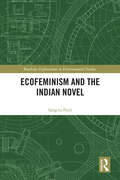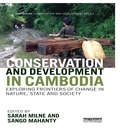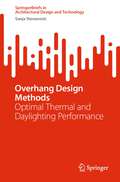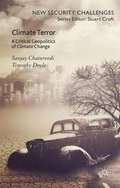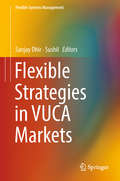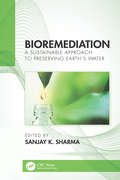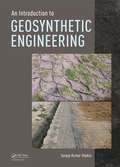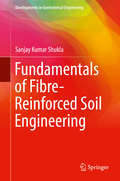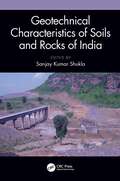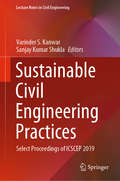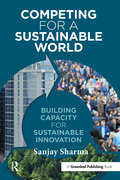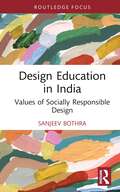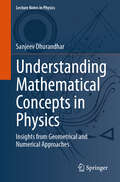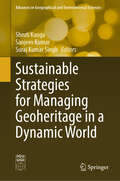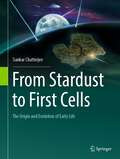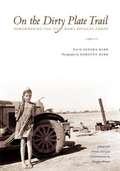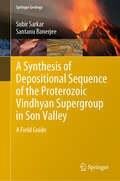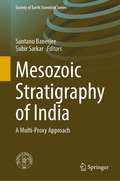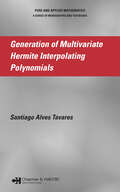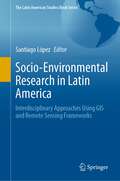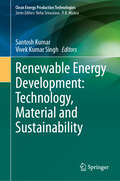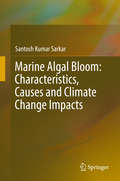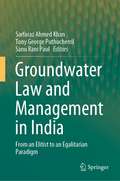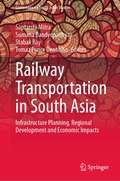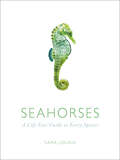- Table View
- List View
Ecofeminism and the Indian Novel (Routledge Explorations in Environmental Studies)
by Sangita PatilEcofeminism and the Indian Novel tests the theories of ecofeminism against the background of India’s often different perceptions of environmental problems, challenging the hegemony of Western culture in thinking about human problems. This book moves beyond a simple application of the concepts of ecofeminism, instead explaining the uniqueness of Indian novels as narratives of ecofeminism and how they can contribute to the development of the theory of ecofeminism. In examining a selection of novels, the author argues that Indian texts conceptualize the ecological crisis more as a human problem than as a gender problem. The book proposes that we should think of ecofeminism as ecohumanism instead, seeing human beings and nature as a part of a complex web. Novels analysed within the text include Kamala Markandaya’s Nectar in a Sieve (1954), Shivram Karanth’s Return to Earth (2002) and Na D’Souza’s Dweepa (2013). Ecofeminism and the Indian Novel will be of great interest to students and scholars of ecofeminism, ecocriticism, ecological feminism, environmental humanities, gender studies, ecological humanities, feminist studies and Indian literature.
Conservation and Development in Cambodia: Exploring frontiers of change in nature, state and society (Earthscan Conservation and Development)
by Sarah Milne Sango MahantyWritten by leading authorities from Australasia, Europe and North America, this book examines the dynamic conflicts and synergies between nature conservation and human development in contemporary Cambodia. After suffering conflict and stagnation in the late twentieth century, Cambodia has experienced an economic transformation in the last decade, with growth averaging almost ten per cent per year, partly through investment from China. However this rush for development has been coupled with tremendous social and environmental change which, although positive in some aspects, has led to rising inequality and profound shifts in the condition, ownership and management of natural resources. High deforestation rates, declining fish stocks, biodiversity loss, and alienation of indigenous and rural people from their land and traditional livelihoods are now matters of increasing local and international concern. The book explores the social and political dimensions of these environmental changes in Cambodia, and of efforts to intervene in and ‘improve’ current trajectories for conservation and development. It provides a compelling analysis of the connections between nature, state and society, pointing to the key role of grassroots and non-state actors in shaping Cambodia’s frontiers of change. These insights will be of great interest to scholars of Southeast Asia and environment-development issues in general.
Overhang Design Methods: Optimal Thermal and Daylighting Performance (SpringerBriefs in Architectural Design and Technology)
by Sanja StevanovicIt is estimated that windows in office buildings are responsible for one third of energy used for their heating and cooling. Designing window shading that balances often contradictory goals of preventing excessive heat gains in hot periods, without compromising beneficial heat gains in cold periods or visual comfort in indoor spaces of modern buildings with highly glazed facades, is an interesting multi-objective optimisation problem that represents an active research topic in the field of building energy and daylighting. Window overhangs are the simplest and most traditional shading devices that are easy to install, highly cost-effective, require low or no maintenance and offer unobstructed views outside. This book provides a review of overhang design methods for optimal thermal and daylighting performance. It starts with a historical overview of methods based on solar positions and shading masks. Next it discusses current research methodology, including shading calculation methods, ways of quantifying thermal and daylighting overhang effectiveness and the use of multi-objective optimisation approaches, together with the case studies that employ them. It further covers methods for designing innovative overhang types such as NURBS outlined overhangs and PV integrated dynamic overhangs. The appendix classifies published overhang case studies according to major climate type and latitude of their locations. As such, the book presents a valuable resource for understanding subtle nuances of interaction between solar radiation, shading devices and indoor comfort. The intended target audience are building energy researchers interested in optimisation of window shading devices.
Climate Terror
by Timothy Doyle Sanjay ChaturvediClimate Terror investigates the highly differentiated geographical politics of global warming. It explores how fear-inducing climate change discourses could result in new forms of dependencies, domination and militarized 'climate security'. In this revealing study from Chaturvedi and Doyle, the concept of environmental security is brought to life through cases of the most pressing environmental issues confronting the Global South, which are creating desperate realities for billions of people. The book proposes the following key questions, crucial to our understanding of this issue: Can the climate discourse be re-configured to provide a place where issues of environmental justice and sovereignty are paramount, rather than neo-liberal responses to climate? Can climate change give a voice to the global periphery, and can it be used as a vehicle for emancipation? Chaturvedi and Doyle's study concludes by taking note of the more optimistic response of 'emancipatory' groups and networks to concepts such as climate justice and climate debt, and the ways in which these groups have attempted to use this global climate moment for more democratic purposes. Is the climate story, regardless of its diverse intentions, a discourse now captured by the affluent North to control the development of the Global South? Has the emancipatory moment now passed or is there still hope for the re-emergence of subaltern perspectives on climate futures? The authors further discuss the deployment of terror vocabulary to address climate change, which is a part of refurbished designs and technologies of control, regulation and domination in a neo-liberal, post-political, globalized world marked by profound asymmetries in terms of economic growth and human development. They argue for an increased understanding of the environment, not as an external enemy force, but as adiverse nature that is inclusive of people, a nature that has the potential to provide secure access to citizens of all countries to basic nutrition, adequate access to health, appropriate shelter, and a security to practice a diverse range of livelihoods.
Flexible Strategies in VUCA Markets (Flexible Systems Management)
by Sushil Sanjay DhirThis book discusses the concepts of volatility, uncertainty, complexity, and ambiguity (VUCA) that are the core of various paradigms used in strategic management to understand competitive advantage as well as flexibility in organizational boundaries. It serves as a valuable reference resource in the area of VUCA markets. An increase in the levels and types of uncertainty has important implications potentially for the durability of a company’s advantages, the way firms learn and adapt, approaches for managing innovation and knowledge, and the attractiveness of different strategies and organizational models. In today’s world, strategic flexibility in VUCA is essential for business leaders to sustain market advantage and attain a clear vision amid the chaos. Business leaders who stay focused and are aware of external volatility as the prevalent characteristic are successful, while those who are not flexible in this VUCA world and lock themselves into fixed positions lose out.The book includes empirical and conceptual research papers along with case studies and models discussing strategies for emerging markets in volatile and uncertain environments. It also covers a variety of issues, including innovation, people and processes, financial management, and leadership and strategies in VUCA markets. Apart from research fraternity and academia, the contents of the book will be useful for practitioners as well as industry watchers.
Bioremediation: A Sustainable Approach to Preserving Earth’s Water
by Sanjay K. SharmaBioremediation: A Sustainable Approach to Preserving Earth’s Water discusses the latest research in green chemistry practices and principles that are involved in water remediation and the quality improvement of water.The presence of heavy metals, dyes, fluoride, dissolved solids and many other pollutants are responsible for water pollution and poor water quality. The removal of these pollutants in water resources is necessary, yet challenging. Water preservation is of great importance globally and researchers are making significant progress in ensuring this precious commodity is safe and potable. This volume illustrates how bioremediation in particular is a promising green technique globally.Features: Addresses bioremediation of all the major water pollutants Approaches the chemistry of water and the concept of water as a renewable resource from a green chemistry aspect Discusses environmental chemistry and the practice of industrial ecology Explains the global concern of adequate high quality water supplies, and how bioremediation can resolve this Explores sustainable development through green engineering
An Introduction to Geosynthetic Engineering
by Sanjay Kumar ShuklaThe development of the use of polymeric materials in the form of geosynthetics has brought about major changes in the civil engineering industry. Geosynthetics are available in a wide range of compositions appropriate to different applications and environments. Over the past three to four decades, civil engineers have grown increasingly interested
Fundamentals of Fibre-Reinforced Soil Engineering
by Sanjay Kumar ShuklaThis book is intended to serve as a one-stop reference on fibre-reinforced soils. Over the past 30-35 years, the engineering behaviour of randomly distributed/oriented fibre-reinforced soil, also called simply fibre-reinforced soil, has been investigated in detail by researchers and engineers worldwide. Waste fibres (plastic waste fibres, old tyre fibres, etc. ) create disposal and environmental problems. Utilization of such fibres in construction can help resolve these concerns. Research studies and some field applications have shown that the fibres can be utilized in large quantities in geotechnical and civil engineering applications in a cost-effective and environmentally friendly manner. This book covers a complete description of fibres, their effects when included within a soil or other similar materials such as the fly ash, and their field applications. It gives a detailed view of fibre-reinforced soil engineering. The book will be useful to students, professional, and researchers alike, and can also serve as a text for graduate coursework and professional development programs
Geotechnical Characteristics of Soils and Rocks of India
by Sanjay Kumar ShuklaThis book presents mainly the geotechnical details of geomaterials (soils and rocks) found in all the 36 states and union territories of India. There are 37 chapters in this book. Chapter 1 provides an overview of geomaterials, focusing on their engineering properties as determined based on the project site investigations and laboratory/field tests; this will help readers understand the technical details explained throughout the book, with each chapter dealing with geomaterials of one state/union territory only. Each chapter, contributed by a team of authors, follows a common template with the following sections: introduction, major types of soils and rocks, properties of soils and rocks, use of soils and rocks as construction materials, foundation and other geotechnical structures, other geomaterials, natural hazards, case studies and field tests, geoenvironmental impact on soils and rocks, concluding remarks and references. All the chapters cover highly practical information and technical data for application in ground infrastructure projects, including foundations of structures (buildings, towers, tanks, machines and so on), highway, railway and airport pavements, embankments, retaining structures/walls, dams, reservoirs, canals and ponds, and landfills and tunnels. These details are also highly useful for professionals dealing with mining, oil and gas projects and agricultural and aquacultural engineering projects. Although this book covers the Indian ground characteristics, the information provided can be helpful in some suitable forms to the professionals of other countries having similar ground conditions and applications.
Sustainable Civil Engineering Practices: Select Proceedings of ICSCEP 2019 (Lecture Notes in Civil Engineering #72)
by Sanjay Kumar Shukla Varinder S. KanwarThis book comprises select proceedings of the International Conference on Sustainable Civil Engineering Practices (ICSCEP 2019). It covers several important aspects of sustainable civil engineering practices dealing with effective waste and material management, natural resources, industrial products, energy, food, transportation and shelter, while conserving and protecting the environmental quality and the natural resource base essential for future development. The book also discusses engineering solutions to sustainable development and green design issues. Special emphasis is given on qualitative guidelines for generation, treatment, handling, transport, disposal and recycling of wastes. The book is intended as a practice-oriented reference guide for researchers and practitioners, and will be useful for all working in sustainable civil engineering related fields.
Competing for a Sustainable World: Building Capacity for Sustainable Innovation
by Sanjay SharmaSustainable innovation requires more than a clear vision and commitment. It requires effective execution and implementation based on an ongoing systematic process of engaging stakeholders to generate the evolving information critical for guiding decision-making, developing and implementing business logic for sustainable innovation, overcoming decision-making biases by managers, creating an opportunity framework to spark creativity, and developing effective organizational capabilities to build a sustainable innovation DNA within the organization. Such a capacity provides an organization with the ability to anticipate and overcome internal and external barriers and achieve competitive advantage through sustainable innovation of products, services, and business models. Based on original research, current state-of-the-knowledge, and relevant examples, this book comprehensively outlines and describes the process that managers can undertake to effectively and successfully implement a sustainability strategy that will help them attract and retain managerial talent; increase operating legitimacy and reduce compliance costs; boost stakeholder support; reduce costs through increased efficiency, quality, reliability, safety, and responsiveness of existing operations; foster radical innovations in processes, products, services, and new markets; and promote competitive imagination of future products, services, and business models.
Design Education in India: Values of Socially Responsible Design (Routledge Research in Social Design)
by Sanjeev BothraThis book traces developments in design education in India and shows the continuing impact of the Bauhaus School of design education, which formed the basis of the National Institute of Design. It presents the findings of the author's research and experiential learning as a design educator over a 25-year period. This book argues that as the effects of climate change and the exploitation of natural and human resources become more pervasive, it has become increasingly important to ensure that the values of social responsibility are instilled into the design students who will become future practitioners. This book offers an alternative model of understanding regarding the ecosystem of design and sustainable design education. Going beyond description and analysis, it includes three case studies of adoptable design curricula created by the author, with student responses to the programmes to provide first-hand insights into their impact. Research findings are based on detailed interviews with contemporary faculty members, all experts in the various design disciplines, along with an in-depth survey of existing design programmes in India. Design Education in India encourages a paradigm shift in thinking about the environment, spaces and places. It offers a unique perspective on the status of design education in an important and fast-growing economy and will be a useful read for design educators and researchers in varied disciplines.
Understanding Mathematical Concepts in Physics: Insights from Geometrical and Numerical Approaches (Lecture Notes in Physics #1030)
by Sanjeev DhurandharModern mathematics has become an essential part of today’s physicist’s arsenal and this book covers several relevant such topics. The primary aim of this book is to present key mathematical concepts in an intuitive way with the help of geometrical and numerical methods - understanding is the key. Not all differential equations can be solved with standard techniques. Examples illustrate how geometrical insights and numerical methods are useful in understanding differential equations in general but are indispensable when extracting relevant information from equations that do not yield to standard methods. Adopting a numerical approach to complex analysis it is shown that Cauchy’s theorem, the Cauchy integral formula, the residue theorem, etc. can be verified by performing hands-on computations with Python codes. Figures elucidate the concept of poles and essential singularities. Further the book covers topology, Hilbert spaces, Fourier transforms (discussing how fast Fourier transform works), modern differential geometry, Lie groups and Lie algebras, probability and useful probability distributions, and statistical detection of signals. Novel features include: (i) Topology is introduced via the notion of continuity on the real line which then naturally leads to topological spaces. (ii) Data analysis in a differential geometric framework and a general description of χ2 discriminators in terms of vector bundles. This book is targeted at physics graduate students and at theoretical (and possibly experimental) physicists. Apart from research students, this book is also useful to active physicists in their research and teaching.
Sustainable Strategies for Managing Geoheritage in a Dynamic World (Advances in Geographical and Environmental Sciences)
by Sanjeev Kumar Shruti Kanga Suraj Kumar SinghThis book delves deeply into the multifaceted challenges of geoheritage management today, including the ever-evolving geological landscape, human impact, and the pressing need for sustainable solutions. At its core, this book explores how sustainable practices can safeguard our geological treasures in the face of an ever-changing world. One of the book's primary takeaways revolves around the imperative of data-driven decision-making in geoheritage conservation. With the integration of cutting-edge technologies and methodologies, readers are exposed to the transformative power of data analytics, remote sensing, and geological mapping. By harnessing these tools, geoheritage managers and conservationists can analyze geological phenomena, monitor landform changes, and make informed decisions to protect and sustainably manage these irreplaceable natural wonders. Climate change, another critical theme of the book, is scrutinized from the perspective of its impact on geoheritage. Geological formations and landscapes are subject to climate-related alterations, ranging from erosion to shifts in flora and fauna. The book elucidates the innovative ways in which sustainable strategies can combat these effects, advocating for resilient geoheritage management practices that account for climatic variations. Furthermore, this book underscores the pivotal role of technology in preserving our geological heritage. From state-of-the-art monitoring devices to Geographic Information Systems (GIS) applications, readers are exposed to the tools and techniques that transforms geoheritage management. Real-world examples illustrate how these technologies are already being deployed, as well as their potential for further advancement to enhance sustainability.
From Stardust to First Cells: The Origin and Evolution of Early Life
by Sankar ChatterjeeThis book presents a groundbreaking hypothesis to answer one of the greatest scientific mysteries: How did life begin? Like a detective piecing together seemingly disparate bits of evidence, Dr. Sankar Chatterjee combines the most recent discoveries in cosmology, geology, chemistry, information systems, and biology, weaving a vast tapestry from the threads of current research. Dr. Chatterjee convincingly argues that the odyssey of life first began when the fundamental building blocks were brought to Earth by meteorites. These cosmic compounds concentrated and simmered like a soup in hydrothermal crater-caldrons. Through a system of subterranean vent networks, a biosynthetic-rich variety of organic compounds mixed and matched into a recipe of rich biomolecules guided by prebiotic information systems. Through symbiosis, these complex biopolymers gradually assemble into membrane-bound protocells. At each stage of this evolutionary progression, through natural selection, they refined with increasing stability and complexity, ultimately leading to the emergence of the first cells about four billion years ago. In this book, Dr. Chatterjee tells this story in rigorous detail in language that is both accessible and engaging.
On the Dirty Plate Trail: Remembering the Dust Bowl Refugee Camps
by Sanora BabbThe 1930s exodus of "Okies" dispossessed by repeated droughts and failed crop prices was a relatively brief interlude in the history of migrant agricultural labor. <P><P>Yet it attracted wide attention through the publication of John Steinbeck's The Grapes of Wrath (1939) and the images of Farm Security Administration photographers such as Dorothea Lange and Arthur Rothstein. Ironically, their work risked sublimating the subjects--real people and actual experience--into aesthetic artifacts, icons of suffering, deprivation, and despair. Working for the Farm Security Administration in California's migrant labor camps in 1938-39, Sanora Babb, a young journalist and short story writer, together with her sister Dorothy, a gifted amateur photographer, entered the intimacy of the dispossessed farmers' lives as insiders, evidenced in the immediacy and accuracy of their writings and photos. Born in Oklahoma and raised on a dryland farm, the Babb sisters had unparalleled access to the day-by-day harsh reality of field labor and family life.
A Synthesis of Depositional Sequence of the Proterozoic Vindhyan Supergroup in Son Valley: A Field Guide (Springer Geology)
by Santanu Banerjee Subir SarkarThis book offers extensive information on the course of sedimentation in the Proterozoic Vindhyan Basin and the potential record of ancient life stored within the rocks. It covers topics ranging from facies analysis to sequence-building, from carbonates to siliciclastics, and mixed lithology and life records from microbial to potentially eukaryotes, along with the basin evolutionary history. Further, the book includes 75 color photographs and accompanying hand-sketches to help readers grasp key aspects of Vindhyan Geology. Vindhyan rocks are well known for their excellent preservation of microbial record of earth. Offering a student-friendly field guide containing detailed route maps, geological maps and a wealth of visual examples, it is also extremely useful in terms of understanding the microbe-dominated environments on Mars.
Mesozoic Stratigraphy of India: A Multi-Proxy Approach (Society of Earth Scientists Series)
by Santanu Banerjee Subir SarkarThis book envisages a multi-proxy approach using stable isotopes, geochemical proxies, magnetic susceptibility and associated biotic events for paleoclimatic and paleoenvironmental interpretations of the Mesozoic sedimentary record of India. Mesozoic rocks of India record abnormal sea level rise, greenhouse climate, intensified volcanism, hypoxia in seawater, extensive black shale deposition, and hydrocarbon occurrence. The Mesozoic has also witnessed mass extinction events, evolution of dinosaurs, and breakdown of the supercontinent Pangea and the formation of Gondwana. Although the Mesozoic geology of India has witnessed significant progress in the last century, literature survey reveals a huge gap in knowledge regarding sequence stratigraphy, chemostratigraphy and key geological events. A synthesis of sedimentological, paleontological and chemical data is included to presenting a comprehensive understanding of the Indian Mesozoic record to students, researchers and professionals.
Generation of Multivariate Hermite Interpolating Polynomials
by Santiago Alves TavaresThis text advances the study of approximate solutions to partial differential equations by formulating a novel approach that employs Hermite interpolating polynomials and by supplying algorithms useful in applying this approach. The book's three sections examine constrained numbers, Hermite interpolating polynomials, and selected applications. The authors outline the rules for writing the algorithms and then present them in pseudo-code. Next, they define the properties that characterize the Hermite interpolating polynomials, propose an expression and demonstrate an algorithm for generating the polynomials, and show the advantages of this new technique over the classical approach.
Socio-Environmental Research in Latin America: Interdisciplinary Approaches Using GIS and Remote Sensing Frameworks (The Latin American Studies Book Series)
by Santiago LópezThis contributed volume presents relevant examples of socio-environmental research that highlight the challenges and opportunities of using geotechnologies in interdisciplinary settings across the vast, culturally, and environmentally mega-diverse region known as Latin America. While remote sensing has been mostly used for mapping and monitoring physical features, geographic information systems open up opportunities for the integration of socio-economic and environmental data collected through individual and community-based surveys, in-situ measurements, and other participatory research techniques to offer additional analytically grounded power when evaluating socio-environmental processes that shape Latin American landscapes. The topics addressed in this book include deforestation and land degradation, borderlands dynamics, agriculture and agroecological systems, environmental conservation and development, public health, tourism, environmental justice, archeology, volunteered geography and urban planning, among others. The book is intended for academics, graduate and undergraduate classrooms, and general audiences with interest in Latin America and the socio-environmental issues that threaten the sustainability of the region and local communities. The book will also appeal to practitioners, managers, and policy makers interested in the application of geo-technologies and field-based research to address complex socio-environmental problems in the Global South.
Renewable Energy Development: Technology, Material and Sustainability (Clean Energy Production Technologies)
by Santosh Kumar Vivek Kumar SinghThis edited volume is a comprehensive guide to understanding and harnessing the power of renewable energy for a sustainable future. In a world dealing with the urgent need to combat climate change and reduce our dependence on fossil fuels, this book provides a new perspective on renewable energy. It is filled with cutting-edge research and practical insights, exploring the technologies, advanced materials, and sustainability practices driving the renewable energy revolution. Renewable energy resources are developing the latest advancements in solar, wind, hydro, geothermal, biomass, tidal, and wave energy technologies. This book is unique and opens a new window on classic renewable energy sources as well as new developments in technology, advanced material innovation, and sustainability aspects leading with various factors such as energy storage, transmission, institutional and economic factors, renewable energy application in smart cities, building and other solar thermal applications, environmental aspects, electrical energy generation, and climate change mitigation potential to achieve net-zero targets. This book is of interest to teachers, researchers, climate change scientists, capacity builders, and policymakers. Additionally, the book serves as an additional reading material for undergraduate and graduate students of sustainable energy, engineering, material science, and environmental sciences. National and international energy, sustainable and material scientists, managers, and policymakers will also find this to be a useful read.
Marine Algal Bloom: Characteristics, Causes and Climate Change Impacts
by Santosh Kumar SarkarIn the marine environment, single-celled, microscopic, plant-like organisms naturally occur in the well-lit surface layer of any body of water. These organisms, referred to as phytoplankton or microalgae, form the base of the food web upon which nearly all other marine organisms depend. Algal bloom is a rapid increase in or accumulation of the population of about 300 species of algae due to excess nutrients (eutrophication), and is of major global interest as it causes reduction in species diversity, abrupt changes in water quality, and discoloration of the water (green, yellow, brown or red) depending on the species of algae and the type of pigments they contain. Dying blooms can also be an environmental concern as when the cells sink and decay, bacteria break down the organic material, which in turn strips oxygen from the water. This microbial oxygen demand at times leads to very low oxygen levels in the bottom waters, harming aquatic life. Documentation of this sporadic high abundance of algae, together with the significant species richness of the diatoms, requires comprehensive studies in the Sundarban coastal environment, which is facing severe degradation due to natural & anthropogenic stressors. In addition, a better understanding of the effects of algal blooms on seafood quality, the complex biological, chemical and physical interactions and subsequent effects on trophodynamics is needed to develop strategies for effective coastal zone management. The book discusses the occurrence of harmful algal blooms (HABs) caused by the dinoflagellates of the genus Alexandrium and Karenia, or diatoms of the genus Pseudo-nitzschia, which have large and varied impacts on marine ecosystems (such as large-scale marine mortality events that have been associated with various types of shellfish poisonings) depending on the species involved, the environment where they are found, and the mechanism by which they exert negative effects. HABs represent a major environmental problem in all regions of the U.S., and their occurrence is on the rise due to increased nutrient pollution. HABs have severe impacts on human health, aquatic ecosystems, and the economy. Such blooms, known colloquially as red tides due to their red or brown hues, are increasing in frequency and magnitude worldwide as a result of changes in oceanic climate, increased coastal eutrophication and enhanced long-distance dispersal in ballast water. As such, the book offers an in-depth account of the complex biological, chemical and physical interactions of the algal blooms (both innocuous and harmful ones). It also discusses the highly topical issue of the impact of global climate change on the frequency and severity of HABs in the context of alterations in temperature, stratification, light and ocean acidification.Focusing on both basic and applied limnology, this book is a reliable and up-to-date reference resource for students, teachers and researchers engaged in the field of coastal research/management at regional and global scales.
Groundwater Law and Management in India: From an Elitist to an Egalitarian Paradigm
by Sarfaraz Ahmed Khan Tony George Puthucherril Sanu Rani PaulThis book presents a comprehensive analysis of the existing nature of India’s groundwater laws. In the backdrop of the gravity of groundwater crisis that threatens to engulf the country, the book examines the correlation between the imperfections in the law and water crisis and advocates a reform agenda to overhaul the legal framework. It accomplishes this objective by examining how some of the States and Union Territories regulate and manage groundwater through the legal instrumentality against the backdrop of the two conflicting paradigms: the “elitist” and the “egalitarian.” The book’s fundamental premise is that despite being an extraordinarily critical resource that supports India’s burgeoning population’s ever-increasing water demands, groundwater is abused and mismanaged. The key argument that it posits is that the elitist paradigm must give way to an egalitarian one where groundwater is treated as a common property resource. To place this message in perspective, the book’s introduction explains the dichotomy between the two paradigms in the context of groundwater. This sets the stage, after which the book is divided thematically into three parts. The first part deals with some of the general groundwater management concerns brought to the fore by the operation of the elitist paradigm. Since water is constitutionally a State subject, the second part analyses the groundwater legislations of different States and Union Territories set against their unique circumstances. As these laws do not dismantle the elitist paradigm that interlocks groundwater rights to land rights, the next part articulates the legal reform agenda where a case is made to re-engineer groundwater laws to reflect a more sustainable basis. The findings and arguments resonate with the situation in many developing countries around the world due to which the book is a valuable resource for researchers across disciplines studying this area, and also for policy makers, think tanks, and NGOs.Groundwater Management–Inter-state Water Conflicts–Aquifers–Water Markets–Water Security–Water Law Reform–Groundwater Law–Water Law–Sustainable Development–Hydrology
Railway Transportation in South Asia: Infrastructure Planning, Regional Development and Economic Impacts (Contemporary South Asian Studies)
by Sumana Bandyopadhyay Tomaz Ponce Dentinho Saptarshi Mitra Stabak RoyThis book discusses policy instruments for sustainable infrastructure developments. Railways are one of the most important developmental instruments of a region, province, or country. They play a crucial role in economic development, urban growth, urban mobility, regional susceptibility, market integration, and world trade. Railways are an integral part of regional and urban development, both in terms of freight and passenger transport. By offering case studies from various regions and cities in South Asia, this book examines the evolution of railway transportation and the impact of these infrastructure projects on regional and urban development. It examines the interactions between evolving infrastructures and competing demands and considers the negative and positive externalities of railway transportation for people, places, and locations. The contributions analyze issues such as network infrastructure planning and technological development, passenger mobility and satisfaction, vulnerability to environmental impacts, and cross-border trade.
Seahorses: A Life-Size Guide to Every Species
by Sara A. LourieAbsolutely captivating creatures, seahorses seem like a product of myth and imagination rather than of nature. They are small, elusive, and are named for their heads, which are shaped like miniature ponies with tiny snouts. They swim slowly upright by rapidly fanning their delicate dorsal fin, coil their tails to anchor themselves in a drift, and spend days in a dancing courtship. Afterward, it is the male who carries the female's eggs in his pouch and hatches the young. Seahorses are found worldwide, and they are highly sensitive to environmental destruction and disturbance, making them the flagship species for shallow-water habitat conservation. They are as ecologically important as they are beautiful. Seahorses celebrates the remarkable variety of seahorse species as well as their exquisiteness. 57 species, including seadragons and pipefish, are presented in lush, life-size photographs alongside descriptive drawings, and each entry includes detailed and up-to-date information on natural history and conservation. Sara Lourie, a foremost expert on seahorse taxonomy, presents captivating stories of species that range from less than an inch to over a foot in height, while highlighting recent discoveries and ecological concerns. Accessibly written, but comprehensive in scope, this book will be a stunning and invaluable reference on seahorse evolution, biology, habitat, and behavior. Masters of camouflage and rarely seen, seahorses continue to be a fascinating subject of active research. This visually rich and informative book is certain to become the authoritative guide to these charming and unusual wonders of the sea, beloved at aquariums the world over.
